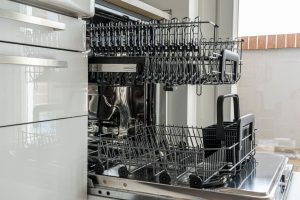Installing a dishwasher can be tricky, but with the right tools and careful planning, it can be installed safely and easily. Here are a few easy steps to help you to understand “how to install a new dishwasher.” Make sure you have all the necessary tools and materials, including a level, a drill, and a wrench. Carefully follow the manufacturer’s instructions for installing the dishwasher, secure it properly and connect all necessary plumbing and electrical connections. With these easy steps, you’ll be able to understand how to install a dishwasher for the first time safely and confidently.
Attach the Electric Cord
Most of the dishwasher’s functional parts, including its electrical and plumbing connections, are located behind a bottom access panel on the front of the unit. To begin, remove the bottom access panel, and locate the power cord connection fittings, water inlet solenoid valve, and drain fitting. Remove the cover on the wire connection housing and thread the power cord into the housing. Make the three wire connections: green wire from the appliance cord to the green grounding screw, white neutral wire to white dishwasher lead and black wire to black dishwasher lead. These connections are typically made with twist-on wire connectors, but some appliances may have different methods.
Hook Up the Water Supply
A dishwasher connector kit includes a dishwasher 90 that will connect the water supply to the dishwasher. A dishwasher 90 is the first step that needs to be completed for your dishwasher to be hooked up to the water supply. Locate the fitting that connects the water inlet to the solenoid valve on the valve. To thread the dishwasher 90 fitting onto the solenoid valve, first, you need to apply a small amount of pipe joint compound to the fitting threads. Once the screws are fully tightened by hand, use channel-lock pliers or an adjustable wrench to tighten an additional 1/4 turn.
Attach Water Supply Line
The dishwasher connector kit includes all the necessary parts to complete the installation, including a braided steel water supply tube. This tube is the conduit through which water will flow from the main water supply line to your dishwasher. You need to thread the coupling nut onto the dishwasher 90 fittings to install the supply tube. This is a compression fitting, meaning it does not require the use of a pipe joint compound. However, it is important to be careful when tightening the fitting, as it can strip the threads if you over tighten it. You can use channel-lock pliers or an adjustable wrench to tighten the fitting. Once the fitting is tightened, you can turn on the water supply and test the connection for leaks.
Position the Dishwasher
To install the dishwasher, place it on its feet facing upwards. Slide it into the designated space under the kitchen counter, ensuring that the power cord, water supply tube, and drain hose are fed through the holes on the side of the cabinet. Position the appliance in the centre of the opening without pushing it too far back. Use the adjustable legs provided to raise and level the dishwasher, following the manufacturer’s instructions. If required, you can use pliers to unscrew the legs to adjust the height of the dishwasher to match the counter height and level it out.
Anchor the Dishwasher
Once the dishwasher is placed in the desired position, you can fasten it. To do this, open the dishwasher door to access the mounting brackets. Then, use the screws provided to attach the brackets to the cabinet frame, which is located under the lip of the countertop. This will ensure that the dishwasher is firmly in place and will not move during use.
Connect the Water Supply Tube
The next step is connecting the end of the water supply tube to the water shut-off valve under the kitchen sink. In case of a new installation, you might have to install the shut-off valve on the hot water pipe. After making the connection, turn the shut-off valve and check for leaks. Inspect the area under the dishwasher to ensure no leaks from the other end of the supply tube where it connects to the dishwasher 90 fittings.
Connect the Drain Hose
In most cases, the rubber drain hose for the dishwasher is already attached to it. In case it hasn’t been attached, a hose clamp can then be used to attach it. Depending on how your sink is configured and the requirements of your local code, there are several possible configurations for the drain hose:
- The dishwasher drain hose can be connected to an air gap fitting mounted on the countertop or sink deck. This fitting is designed to introduce air into the drain hose, which prevents wastewater from flowing back into the dishwasher. After the air gap, a second hose is connected either to a nipple on the garbage disposal or to a side nipple on the sink drain tailpiece. The hose from the dishwasher is usually fixed to the air gap using a spring clip, while the hose is connected to the garbage disposer using a hose clamp.
- An alternative way of connecting the dishwasher drain hose is by looping it up and securing it to the underside of the countertop, then allowing it to drop down again to connect to a nipple on the garbage disposal or to the sink drain tailpiece. This “high loop” method serves the same purpose as an air gap: to prevent dirty water from flowing back into the dishwasher.
Test the Dishwasher
Connect the electric cord of the dishwasher to an outlet. Before installing the face plate on the front of the appliance, test it by running a full cycle. Ensure that the dishwasher is taking in fresh water properly and that the drain water is flowing correctly, with no leaks at any of the connections. Finally, install the face plate on the bottom front of the dishwasher.
Can you install a dishwasher without a plumber?
Installing a dishwasher may seem like a simple DIY job, but it is important to remember how hard is it to install a dishwasher by yourself because it involves working with plumbing and electrical connections, which can be complex. To ensure that the dishwasher is installed correctly and to avoid any plumbing issues, it is best to hire a professional plumber to do the job for you. A professional will have the experience and knowledge to properly connect the dishwasher to the water supply, drain system and electrical power. Hiring a professional ensures that the installation is done correctly and safely, and you can enjoy the convenience and efficiency of a working dishwasher without any issues.
What is required to install a dishwasher?
Installing a dishwasher requires key components and tools to ensure proper set-up. Firstly, a dishwasher connector kit is necessary that includes parts for connecting the dishwasher to the water supply and drain, such as a braided steel water supply tube, drain hose, and mounting brackets, is required. Basic hand tools like screwdrivers, adjustable wrenches, and pliers may also be necessary for the installation. An electrical outlet near the dishwasher location, a nearby water supply shut-off valve, and a properly sized drain pipe or an air gap fitting are also needed for the installation.
How much does it cost to get a dishwasher installed?
If you are curious about “how much to install a dishwasher,” it is important to know that on average, professionals charge between $100 and $450 for a basic dishwasher installation into a pre-existing infrastructure. The cost can vary depending on factors such as the location, the job’s complexity, and the professional’s experience. The average cost for a basic installation is around $190. In addition to the installation cost, it’s important to consider other expenses that may be incurred, such as additional parts and materials, and any additional services that may be required, such as moving the location of the dishwasher.
Should I pay someone to install a dishwasher?
If you are comfortable working with plumbing and electrical connections and you have experience with basic home repairs, you may be able to install a dishwasher on your own. However, if you are not comfortable with the task, and don’t know how to install a dishwasher in Australia, it is better to hire a professional. Installing a dishwasher requires skill and expertise and it is also very important to know how long does it take to install a dishwasher. A professional plumber will have the experience and knowledge to properly install the dishwasher within 1 to 2 hours and ensure it functions correctly and safely. Hiring a professional from Dishwasher repairs in Adelaide can save you time and hassle and give you peace that the job is done correctly.
Do dishwashers come with everything needed to install?
Dishwashers typically come with most of the parts needed for installation but not all. Some dishwashers may come with a connector kit that includes a water supply tube, drain hose, and mounting brackets. However, it is not guaranteed that all the parts needed for installation will be included with the dishwasher. You may need to purchase additional parts such as hose clamps, mounting hardware, and electrical cords.
Do dishwashers come with power cords?
Dishwashers typically do not come with power cords included in the package. This is because the power cord is considered a separate component and is not included with the dishwasher. Some manufacturers may include a power cord with the dishwasher, but it is not a standard practice. This is because most homes already have an electrical outlet near the dishwasher location, and the homeowner is expected to use the existing outlet.
Contact us if you need appliance repair in Adelaide, Australia.



